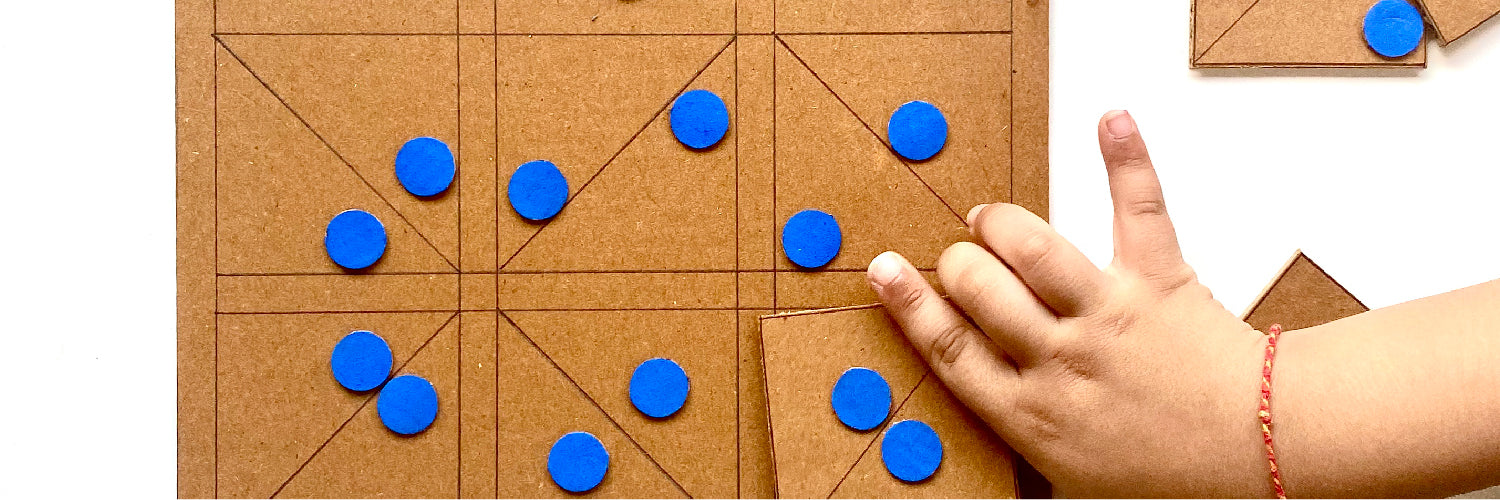How do you tell apart a 2 Rupee coin from a 5 Rupee coin, an apple from a tomato, or a leopard from a cheetah?
While each of these pairs may be similar, there are slight differences in pattern, style, and shades which help us make distinctions. Being able to identify such subtle differences in the way things look is called visual discrimination.
Visual discrimination not only helps us pay attention to detail and tell things apart, but is crucial in life skills such as reading, writing, and counting.
As adults, this comes to us easily. But it takes time, practice, and engaging challenges for a child to master this skill.
So if you are practising visual discrimination with your little one right now, this week’s Co-Create activity is perfect for you!
Benefits of Dot Visual Discrimination
This week’s activity is once again brought to you by Anushikha Bansal, a DIY blogger and homeschooling mom to 3-year-old Atharv. You can see Anushikha’s previous Co-Create activities here.
This activity is called Dot Visual Discrimination and is perfect to help your child hone their ability to notice the subtleties in what they see. The benefits of playing this game include:
1. Develops hand-eye coordination: Holding, moving, and placing the pattern cards in the right spots will hone your child’s fine motor skills and hand-eye coordination.
2. Sharpens problem solving abilities: Matching each card with its corresponding grid space on the board to complete the puzzle as quickly as possible will improve their problem solving abilities.
3. Strengthens visual discrimination: Being able to tell apart the patterns on each card and match them to the grids on the board will strengthen their visual discrimination skills.
4. Betters spatial awareness: The patterns on the cards are all about exactly where each sticker is placed. Understanding this will hone your child’s spatial awareness.
5. Improves concentration: Working to complete the whole board is fun, but requires time. Doing so will increase your child’s patience, focus, and concentration.
6. Aids overall cognitive development: Playing this game will encourage your child to learn shapes, numbers, counting, and strategy, spurring overall cognitive development.
Creating the game

Age recommendation:
This activity can be enjoyed by children between 3 to 6 years.
Material required:
1. Recycled cardboard
2. Dot stickers
3. A cutter
4. A ruler
5. A black marker or pen
How to create the game:

1. Take the piece of cardboard and cut out two big squares of equal dimensions from it.
2. Divide each of the large squares into 9 smaller squares. Then divide the smaller squares further into two triangles, as shown in the picture above.
3. Take one of the large squares and cut out the small squares on it. These will be your pattern cards.
4. On each of the cards, stick dot stickers in different patterns.
5. Replicate each card onto the grids of the uncut square.
Playing Dot Visual Discrimination

The aim of this game is to get your child to match the pattern cards with the grids on the board. Ask them to count the number of stickers on each card, then look at the placement of the stickers, and find the matching pattern on the board.
Another way to play this game is to leave the board blank and use buttons to recreate the patterns from the cards onto the board. For both games, you could up the challenge by timing your child and encouraging them to beat their high scores!
We hope you’ve enjoyed this activity. If you would like to share the experience of your child playing this game, tag us at #CoCreatewithshumee. Take care and stay safe!
Anushikha Bansal is a DIY blogger and the co-creator of #noprepkidsactivity. You can follow her @toddler_ed on Instagram.
